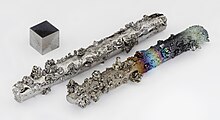Native tungsten
 |
|||||||||||||||||||||||||||||||||||||||||
| General properties | |||||||||||||||||||||||||||||||||||||||||
|---|---|---|---|---|---|---|---|---|---|---|---|---|---|---|---|---|---|---|---|---|---|---|---|---|---|---|---|---|---|---|---|---|---|---|---|---|---|---|---|---|---|
| Pronunciation |
/ˈtʌŋstən/ |
||||||||||||||||||||||||||||||||||||||||
| Alternative name | wolfram, pronounced: /ˈwʊlfrəm/ (WUUL-frəm) | ||||||||||||||||||||||||||||||||||||||||
| Appearance | grayish white, lustrous | ||||||||||||||||||||||||||||||||||||||||
| Standard atomic weight (Ar, standard) | 183.84(1) | ||||||||||||||||||||||||||||||||||||||||
| Tungsten in the periodic table | |||||||||||||||||||||||||||||||||||||||||
|
|||||||||||||||||||||||||||||||||||||||||
| Atomic number (Z) | 74 | ||||||||||||||||||||||||||||||||||||||||
| Group | group 6 | ||||||||||||||||||||||||||||||||||||||||
| Period | period 6 | ||||||||||||||||||||||||||||||||||||||||
| Element category | transition metal | ||||||||||||||||||||||||||||||||||||||||
| Block | d-block | ||||||||||||||||||||||||||||||||||||||||
| Electron configuration | [Xe] 4f14 5d4 6s2 | ||||||||||||||||||||||||||||||||||||||||
|
Electrons per shell
|
2, 8, 18, 32, 12, 2 | ||||||||||||||||||||||||||||||||||||||||
| Physical properties | |||||||||||||||||||||||||||||||||||||||||
| Phase (at STP) | solid | ||||||||||||||||||||||||||||||||||||||||
| Melting point | 3695 K (3422 °C, 6192 °F) | ||||||||||||||||||||||||||||||||||||||||
| Boiling point | 6203 K (5930 °C, 10706 °F) | ||||||||||||||||||||||||||||||||||||||||
| Density (near r.t.) | 19.25 g/cm3 | ||||||||||||||||||||||||||||||||||||||||
| when liquid (at m.p.) | 17.6 g/cm3 | ||||||||||||||||||||||||||||||||||||||||
| Heat of fusion | 52.31 kJ/mol | ||||||||||||||||||||||||||||||||||||||||
| Heat of vaporization | 774 kJ/mol | ||||||||||||||||||||||||||||||||||||||||
| Molar heat capacity | 24.27 J/(mol·K) | ||||||||||||||||||||||||||||||||||||||||
Vapor pressure
|
|||||||||||||||||||||||||||||||||||||||||
| Atomic properties | |||||||||||||||||||||||||||||||||||||||||
| Oxidation states |
6, 5, 4, 3, 2, 1, 0, −1, −2, −4 |
||||||||||||||||||||||||||||||||||||||||
| Electronegativity | Pauling scale: 2.36 | ||||||||||||||||||||||||||||||||||||||||
| Ionization energies |
|
||||||||||||||||||||||||||||||||||||||||
| Atomic radius | empirical: 139 pm | ||||||||||||||||||||||||||||||||||||||||
| Covalent radius | 162±7 pm | ||||||||||||||||||||||||||||||||||||||||
|
|||||||||||||||||||||||||||||||||||||||||
| Miscellanea | |||||||||||||||||||||||||||||||||||||||||
| Crystal structure | body-centered cubic (bcc) | ||||||||||||||||||||||||||||||||||||||||
| Speed of sound thin rod | 4620 m/s (at r.t.) (annealed) | ||||||||||||||||||||||||||||||||||||||||
| Thermal expansion | 4.5 µm/(m·K) (at 25 °C) | ||||||||||||||||||||||||||||||||||||||||
| Thermal conductivity | 173 W/(m·K) | ||||||||||||||||||||||||||||||||||||||||
| Electrical resistivity | 52.8 nΩ·m (at 20 °C) | ||||||||||||||||||||||||||||||||||||||||
| Magnetic ordering | paramagnetic | ||||||||||||||||||||||||||||||||||||||||
| Magnetic susceptibility | +59.0·10−6 cm3/mol (298 K) | ||||||||||||||||||||||||||||||||||||||||
| Young's modulus | 411 GPa | ||||||||||||||||||||||||||||||||||||||||
| Shear modulus | 161 GPa | ||||||||||||||||||||||||||||||||||||||||
| Bulk modulus | 310 GPa | ||||||||||||||||||||||||||||||||||||||||
| Poisson ratio | 0.28 | ||||||||||||||||||||||||||||||||||||||||
| Mohs hardness | 7.5 | ||||||||||||||||||||||||||||||||||||||||
| Vickers hardness | 3430–4600 MPa | ||||||||||||||||||||||||||||||||||||||||
| Brinell hardness | 2000–4000 MPa | ||||||||||||||||||||||||||||||||||||||||
| CAS Number | 7440-33-7 | ||||||||||||||||||||||||||||||||||||||||
| History | |||||||||||||||||||||||||||||||||||||||||
| Discovery | Carl Wilhelm Scheele (1781) | ||||||||||||||||||||||||||||||||||||||||
| First isolation | Juan José Elhuyar and Fausto Elhuyar (1783) | ||||||||||||||||||||||||||||||||||||||||
| Named by | Torbern Bergman (1781) | ||||||||||||||||||||||||||||||||||||||||
| Main isotopes of tungsten | |||||||||||||||||||||||||||||||||||||||||
|
|||||||||||||||||||||||||||||||||||||||||
Tungsten, or wolfram, is a chemical element with symbol W and atomic number 74. The name tungsten comes from the former Swedish name for the tungstate mineral scheelite, from tung sten "heavy stone". Tungsten is a rare metal found naturally on Earth almost exclusively in chemical compounds. It was identified as a new element in 1781, and first isolated as a metal in 1783. Its important ores include wolframite and scheelite.
The free element is remarkable for its robustness, especially the fact that it has the highest melting point of all the elements discovered, melting at 3422 °C (6192 °F, 3695 K). It also has the highest boiling point, at 5930 °C (10706 °F, 6203 K). Its density is 19.3 times that of water, comparable to that of uranium and gold, and much higher (about 1.7 times) than that of lead. Polycrystalline tungsten is an intrinsically brittle and hard material (under standard conditions, when uncombined), making it difficult to work. However, pure single-crystalline tungsten is more ductile, and can be cut with a hard-steel hacksaw.
Tungsten's many alloys have numerous applications, including incandescent light bulb filaments, X-ray tubes (as both the filament and target), electrodes in TIG welding, superalloys, and radiation shielding. Tungsten's hardness and high density give it military applications in penetrating projectiles. Tungsten compounds are also often used as industrial catalysts.
...
Wikipedia


